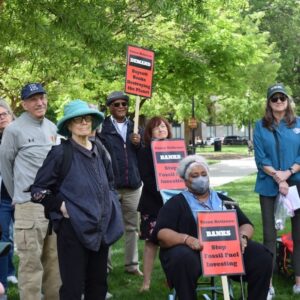December 23, 2014
Is Sub-Contracting Cheaper? Really?
As we prepare to negotiate a new collective bargaining agreement, one of the most important issues to resolve is what constitutes a “fair cost comparison of all reasonable costs.” It’s fair to say that this is a key issue for the Motor Vehicle Craft, especially if we are to return subcontracted work to our members.
The Memorandum of Understanding (MOU) on “Contracting or Insourcing of Contracted Service,” which is part of the 2010-2015 Collective Bargaining Agreement, provided the Motor Vehicle Craft with language we could sink our teeth into for the very first time. It states:
“It is understood that if the service can be performed at a cost equal to or less than that of contract service, when a fair comparison is made of all reasonable costs, the work will be performed in-house.”
The problem is that the United States Postal Service can’t determine what subcontracting costs.
Can’t Determine Its Own Costs
In fact, the Postal Service can’t determine the average cost per hour of its own employees working at its own Vehicle Maintenance Facilities. Management says the rate varies from one facility to another, based on local overhead, expenses, salaries and employee productivity.
The variance in rates is outrageous, however. In one facility, local management listed the cost of a VMF employee as $98 per hour. That exorbitant figure pales in comparison to any other VMF hourly rate submitted by the Postal Service.
Similarly, the Postal Service uses inflated figures when calculating the hourly cost of PVS employees. Management claims a Level 7 employee costs $53.01 per hour, and a Level 8 employee costs $54.21 per hour.
The numbers appear to be taken from the National Average Labor Rates, a table prepared by the USPS, which shows that management is applying so-called “service-wide costs” to increase its estimation of wages by approximately 14 percent.
Not the Last Dollar
The Postal Service also sustains numerous expenses it doesn’t pass on to contractors.
A good example is the cost of parking on postal property. That’s a massive benefit Highway Contract Routes (HCRs) get for free. In many metropolitan areas the cost of parking a single large truck is more than $300 a month.
And while contractors submit a bottom-dollar figure when bidding on contracts or routes, that’s not necessarily the last dollar they receive from the Postal Service.
The Postal Service pays contractors for “Extra Trips,” which are defined as infrequent trips made in addition to those that are outlined in the contract. There are at least two separate costs associated with extra trips. The first is the cost associated with authorizing and processing payment due to the supplier; the second is the cost associated with actual payment.
Pinpointing the specific costs associated with managing the process has proven to be elusive.
Report Reveals Flaws
The USPS Office of Inspector General (OIG) recently revealed that in the fourth quarter of fiscal year 2013, one district paid $1.1 million for 7,386 extra trips. The report concluded that the district could have avoided 9.3 percent of the extra trips during that period, which cost $53,927.
The OIG also found that management frequently failed to follow proper procedures for authorizing and documenting extra trips. More than 49 percent of PS Forms 5397 were not completed properly – that’s 3,163 of 6,342 forms!
Additionally, the OIG found that local officials didn’t always review or authorize the forms and, in some cases, recorded the number of miles incorrectly.
Consequently, the district incurred $536,643 in costs that were not properly supported or authorized. Furthermore, the OIG found that the Postal Service made 34 interest payments because the appropriate forms were not submitted.
If the work had been done in-house by Postal Vehicle Service (PVS) employees, the cost to the USPS would have been minimal and the savings captured significant. We all know PVS drivers make extra trips on a regular basis without the need to complete extra forms or incur extra costs beyond their hourly wage.
Fantastic Voyage
Another benefit passed on to HCRs is the use of the Voyager Card. This complex program permits more than 400 contractors with more than 4,000 contracts to use more than 12,000 Voyager Cards to purchase fuel.
The USPS has spent $5.1 billion on the purchase of 1.6 billion gallons of fuel as part of the HCR Voyager Card Program from its inception in 2005 through 2013.
After conducting two recent studies, the OIG concluded that, “The HCR Voyager Card Program implemented by the Postal Service in 2005 is not effective and other options should be considered.”
In a separate report, the OIG found the Postal Service had failed to establish adequate controls to safeguard the program against waste, fraud and abuse. In an initial investigation of the period from 2006 through 2013, the OIG identified 63 cases of significant fraud by companies and individuals. And while the investigation continues, it has become increasingly difficult to identify fraud due to weak controls and practices associated with the HCR Voyager Card Program.
The OIG goes on to state:
“Furthermore, the Postal Service has incurred more in program costs than what it expected to save. This is contrary to the Postal Service’s claim that the program saves $50 million a year ($17 million from unused gallons and $33 million from discounts and rebates). Based on our prior work, beginning in FY 2011, we questioned about $489 million in expenditures associated with this program due to significant control weaknesses. Moreover, we estimate that the Postal Service has incurred and will continue to incur about $10.7 million annually in additional costs because of these control weaknesses.
“The HCR Voyager Card Program is not manageable given the level of risk and the significant resources required for providing enhancements and critical oversight…”
The union has filed a dispute protesting management’s use of inflated service-wide costs, and we will continue to press the USPS to include all costs associated with HCRs as part of a fair cost comparison. In several correspondence we requested to meet with management about what constitutes a fair cost comparison; they have yet to respond.



